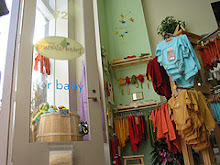 There are so many reasons to consider cloth diapers! And thanks to the Real Diaper Association, we’ve listed a few facts below:
There are so many reasons to consider cloth diapers! And thanks to the Real Diaper Association, we’ve listed a few facts below:* Environmental: A typical disposable diaper takes up to 500 years to decompose and an estimated 27.4 billion diapers are used each year in the U.S. That’s a lot of diapers just sitting around waiting to decompose! In contrast, cloth diapers can be reused over 200 times before they need to be turned into rags, which can then be used indefinitely. And oftentimes, cloth diapers can be used for two children. Disposable diapers simple perpetuate the culture of continued consumption without any thought for natural resources or the environment.
* Economic: The average baby uses about 6,000 diapers throughout the first two years of life. At a typical cost of 25 cents per disposable diaper, parents can expect to pay around $66 per month (or $1600 per year) on disposable diapers. In contrast, using cloth diapers tends to cost between $300 and $1000. The wide discrepancy in price is because of the various styles/ materials that can be used for diapering. But think about it this way: even if you spend $1000 (the upper end of the cloth diapering spectrum), you’re still spending less than with disposables. Significantly less.

* Health: Disposable diapers contain traces of Dioxin, an extremely toxic by-product of the paper-bleaching process. It is a carcinogenic chemical, listed by the EPA as the most toxic of all cancer-linked chemicals. It is banned in most countries, but not the U.S. Additionally, disposable diapers contain sodium polyacrylate, a type of super absorbent polymer (SAP), which becomes a gel-like substance when wet. A similar substance had been used in super-absorbency tampons until the early 1980s when it was revealed that the material increased the risk of toxic shock syndrome. Cloth diapers are a far safer choice.
So these are not your grandmother’s old cloth diapers! No laborious folding (if you don’t want it) and no pins necessary (though Snappis are nice!). Instead these cloth diapers are easy, organic, economically-friendly and just plain adorable!
Check out our many cloth diapering products here. Stay tuned for our next cloth diapering blog post featuring tips on the care and cleaning of your diapers!





No comments:
Post a Comment